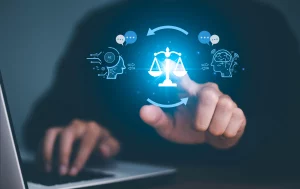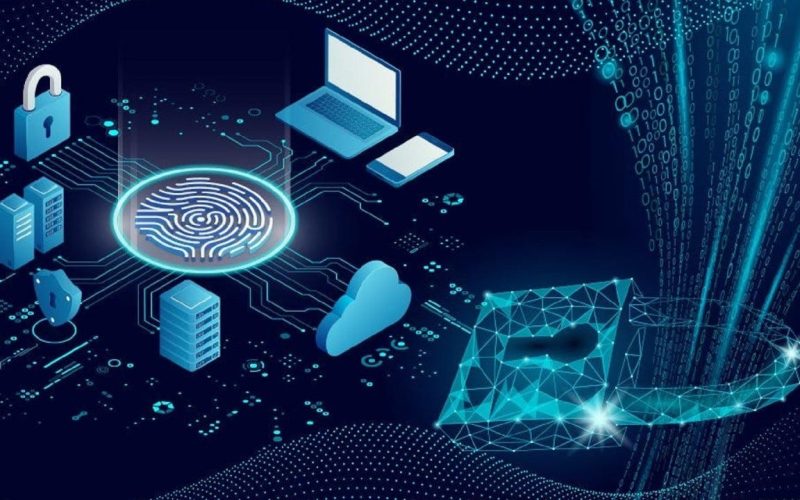Introduction to AI in Cybersecurity
In today’s digital age, Artificial Intelligence (AI) is revolutionizing the field of cybersecurity. As the volume and sophistication of cyber threats grow, AI provides unparalleled opportunities to protect sensitive data, detect breaches, and mitigate risks. However, it also presents challenges, as cybercriminals leverage AI to launch more advanced and automated attacks. This dual-edged nature of AI underscores the urgency of understanding its implications for cybersecurity.
AI-Driven Cyber Threats

AI’s ability to process vast amounts of data and identify patterns is a double-edged sword. Cybercriminals exploit AI to enhance the scale, speed, and stealth of their attacks. AI-powered tools can generate convincing phishing emails, bypass traditional defenses, and even create malware that adapts to evade detection.
Example: Amazon’s Cybersecurity Battle
Amazon, one of the world’s largest technology companies, has revealed that it detects nearly 1 billion potential cyber threats daily. This staggering number highlights the increasing sophistication of AI-driven cyberattacks. Adversaries use AI to analyze vast amounts of online data, identifying vulnerabilities to exploit across Amazon’s extensive infrastructure.
The Rise of AI in Cyberattacks
AI enables attackers to:
- Automate repetitive tasks such as scanning networks for weak points.
- Create highly convincing deepfake videos and audio for social engineering attacks.
- Develop polymorphic malware that evolves to avoid detection.
As these examples illustrate, the integration of AI into cybercriminal arsenals necessitates more robust defensive measures.
AI-Powered Cyber Defense Mechanisms
On the defensive side, AI offers powerful tools to combat threats, mitigate risks, and enhance overall cybersecurity posture. These tools rely on machine learning algorithms, natural language processing, and predictive analytics to identify and address vulnerabilities.
1. Threat Detection
AI-driven systems can analyze massive datasets in real time, identifying anomalies that signal potential threats. For example:
- Pattern Recognition: AI identifies irregular user behavior, such as unusual login times or unexpected file transfers, flagging them as potential breaches.
- Zero-Day Exploit Detection: Machine learning models can predict vulnerabilities in systems that have not yet been exploited.
2. Incident Response
AI systems enable faster and more effective responses to incidents. Automated tools can isolate infected systems, neutralize malware, and prevent its spread. This reduces the downtime and damage caused by attacks.
3. Vulnerability Management
AI can prioritize vulnerabilities based on the risk they pose, allowing organizations to allocate resources efficiently. For example, AI systems may determine that a vulnerability in a customer-facing application is more critical than one in an internal system.
Case Study: Google’s AI Cybersecurity Initiative
Google employs AI extensively to protect its infrastructure and users. The company’s machine learning models analyze billions of emails daily to detect phishing attempts. Google’s AI also helps automate incident responses, ensuring that threats are mitigated swiftly.
The Growing Scale of Cyber Threats

The increasing reliance on digital platforms has amplified the scale of cyber threats. AI’s role in this escalation cannot be understated, as attackers deploy automated tools to launch widespread attacks with minimal effort.
Statistics on the Threat Landscape
- Cyberattacks have increased tenfold in the past decade, with AI-driven tools contributing significantly.
- A single AI-powered botnet can launch millions of phishing attacks or distribute malware across global networks in seconds.
Global Implications
AI-driven threats have global consequences, affecting industries ranging from finance and healthcare to government operations. The sheer volume of attacks makes traditional cybersecurity methods obsolete, necessitating AI-powered solutions.
National Security Concerns
AI is also playing a pivotal role in state-sponsored cyber operations. Governments around the world are leveraging AI for both offensive and defensive purposes.
Case Study: Russia’s AI-Driven Cyber Attacks
The UK government has expressed concerns about Russia’s use of AI to conduct cyberattacks targeting critical infrastructure. These attacks aim to disrupt national systems, steal sensitive data, and undermine public trust. In response, the UK has established an AI security research laboratory, funded by £8 million, to develop countermeasures.
Strategic Partnerships for National Defense
Countries are increasingly collaborating to bolster their cybersecurity defenses. NATO, for instance, is integrating AI technologies into its defense strategy to protect member states from AI-enabled threats.
Regulatory and Compliance Measures
Recognizing the dual-edged nature of AI in cybersecurity, regulatory bodies have introduced guidelines to mitigate risks and promote safe AI practices.
New York State DFS Guidelines
The New York State Department of Financial Services recently issued guidelines for financial institutions to address AI-related cybersecurity risks. Key recommendations include:
- Conducting comprehensive risk assessments.
- Updating incident response plans to address AI-driven threats.
- Monitoring and managing AI systems to prevent misuse.
Global Trends in Regulation
Regulations worldwide are evolving to keep pace with AI advancements. The European Union, for instance, has introduced the Artificial Intelligence Act, which sets standards for the ethical use of AI in cybersecurity.
Ethical and Legal Challenges in AI Cybersecurity

The integration of AI into cybersecurity raises significant ethical and legal concerns. Striking a balance between security and privacy is a persistent challenge.
Privacy Concerns
AI systems often require access to sensitive data to function effectively. This raises questions about data privacy and the potential for misuse.
Legal Implications
- Accountability: Determining liability in cases of AI-driven cyberattacks is complex.
- Regulatory Compliance: Organizations must navigate an evolving legal landscape to ensure compliance with global AI and cybersecurity laws.
Example: AI and Surveillance
AI-powered monitoring tools, while effective at detecting threats, can blur the line between security and surveillance, raising ethical concerns about their use.
Industry-Specific Applications
AI’s role in cybersecurity varies across industries, addressing unique challenges and opportunities.
1. Financial Sector
AI is crucial for detecting fraudulent activities, such as unauthorized transactions or identity theft. Machine learning models analyze transaction patterns in real time to identify anomalies.
2. Technology Sector
AI secures IoT devices and cloud infrastructure, addressing vulnerabilities inherent in connected systems.
3. Healthcare
AI protects sensitive patient data and ensures compliance with regulations such as HIPAA. It also helps detect breaches in medical devices connected to hospital networks.
Case Study: AI in Banking
Major banks use AI to combat fraud, analyzing millions of transactions daily to identify suspicious activities. For example, AI flagged and prevented a $100,000 fraudulent transfer in a recent case involving phishing.
Future Trends in AI and Cybersecurity
As AI continues to evolve, its impact on cybersecurity will grow, creating new opportunities and challenges.
1. Generative AI and Cybersecurity
Generative AI tools, such as ChatGPT, can be misused to create phishing emails or develop malware. However, these tools can also be used defensively to generate reports, analyze threats, and educate users.
2. Predictive Analytics
AI’s predictive capabilities will become more sophisticated, allowing organizations to anticipate and prevent attacks before they occur.
3. Autonomous Cyber Defense
AI systems are moving toward autonomy, enabling them to act without human intervention in certain scenarios. This reduces response times and enhances effectiveness.
Benefits of AI in Cybersecurity
The adoption of AI in cybersecurity offers numerous advantages:
- Efficiency: Automated systems handle large volumes of data, reducing the workload on human analysts.
- Accuracy: AI reduces false positives and identifies genuine threats more effectively.
- Scalability: AI-powered tools can protect vast networks and systems simultaneously.
- Cost Savings: By preventing breaches, AI reduces the financial impact of cyberattacks.
Best Practices for AI Integration in Cybersecurity
To harness AI’s potential effectively, organizations should follow these best practices:
- Invest in AI Training: Educate staff on the use and limitations of AI tools.
- Update Systems Regularly: Ensure AI systems are updated to address emerging threats.
- Adopt a Holistic Approach: Integrate AI with existing security measures for comprehensive protection.
- Monitor AI Systems: Continuously monitor AI tools to prevent misuse or errors.
Conclusion
AI is transforming the cybersecurity landscape, offering innovative solutions to combat ever-evolving threats. While it presents challenges, such as ethical concerns and the potential for misuse, its benefits far outweigh the risks when implemented responsibly. By staying informed about AI advancements, adhering to best practices, and embracing regulatory guidance, organizations can leverage AI to build a more secure digital future.










